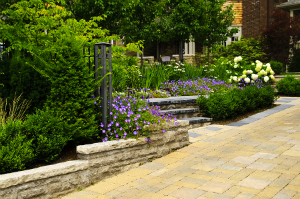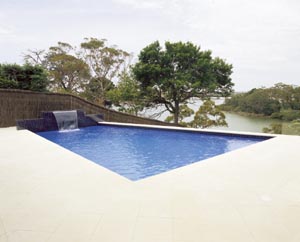
Words: Karen Booth
Paving can represent a significant investment in a backyard. There is the cost of the pavers themselves, then the cost of installation. The keys to protecting that investment are to buy the right pavers for the location, to buy the best quality you can afford and to spend a little time regularly maintaining paved areas.
While paving is a lower-maintenance alternative to lawn, like the floors inside your home, your paved outdoor areas need some regular attention to keep them looking their best — and quick action in the face of spills.
The effects of exposure to the elements, stains from falling leaves, fruit, food and metal, as well as cracking over time can be minimised if pavers are regularly cleaned and maintained, says Boral Clay and Concrete Marketing Manager, Priscila Manio.
According to Priscila, paver care is a simple enough matter if you just follow a regular maintenance regime. Some helpful tips include:
– Sweep regularly with a stiff bristled broom to clean away leaves, dust and other debris.
– Regularly pull up any weeds and grass that may be growing between the pavers. Don’t wait until seed heads form.
– Seal pavers after installation with a penetrating sealer. Ask a reputable sealing company for advice.
- Re-seal pavers as required, taking special care in heavy wear areas and salt-water locations.
– If doing building work, cover the paved areas to protect against damage.
– At all times protect pavers against possible staining from mortar, oxides, cement and rust.
– To avoid rust stains, make sure metal outdoor furniture and barbecue bases are properly sealed.
– Do not use acid or high-pressure cleaning equipment to clean pavers.
– Always try to clean a stain before it hardens or dries up.
Of course, some staining is inevitable, especially if the pavers are in an entertaining area or an area used by children at play. Before taking any action, advises Priscila, first work out what the stain is and then you can use the appropriate stain removal method. Here are a few examples:
– New pavers sometimes suffer from efflorescence, a naturally occurring process in concrete products. The white powdery deposit is salt leaching to the surface of the paver. Clean this by first sweeping with a stiff-bristled broom. Then hose with clean water, if restrictions in your area allow. Weathering will eventually stop efflorescence from occurring.
– For leaf, bark, algae, food and wine stains, use a solution of bleach diluted with water, then rinse with clean water.
– Chewing gum stuck on pavers should first be frozen with dry ice and then removed with a spatula.
Natural stone paving can be more susceptible to staining, but with a deep penetrating sealer, says Dry-Treat’s Global Marketing Manager, Gabriel Chapman, you can keep even the most porous natural stone and paving, as well as tile and brick, looking great for many years. And not only will these products maintain their beauty, they’ll be easier to clean, too.
“Staining is the most common problem affecting such porous materials as stone paving and steps, but there are other common types of damage,” says Gabriel. “Water can be harmless, but if stone or paving is wet for long enough, moulds and bacteria take hold and the material can be softened and weakened. Water also contains minerals (salts) which can leave unsightly residues or stains and even cause major corrosion of pavers and tiles.”
Another good tip is to buy extra pavers when putting in your original order. This isn’t just a good idea in case of breakages or accidents when laying pavers; it gives you a supply of replacement pavers in case any should become cracked, chipped or badly stained with use. By having some spares on hand you will be using replacement pavers from the same batch so you can be assured of perfect colour-matching.








